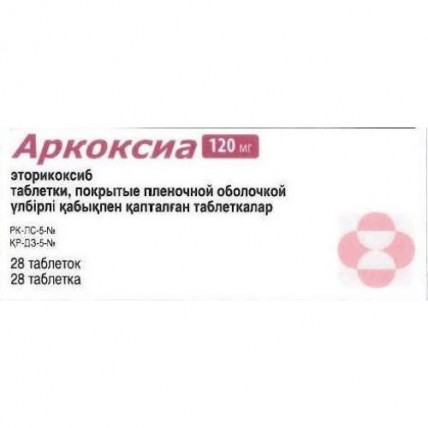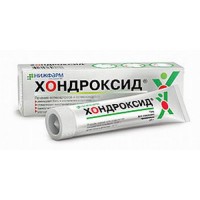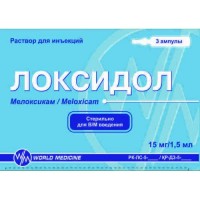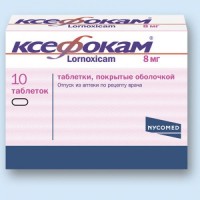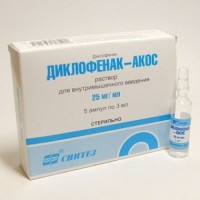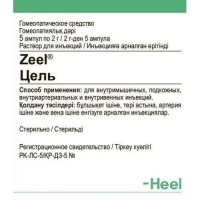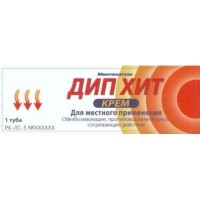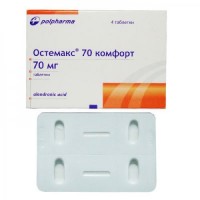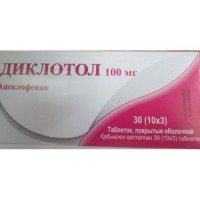Arcoxia® 28's 120 mg film-coated tablets
- $53.90
Out Of Stock
Sku:
7f637f62b92e
Brand:
Frosst Iberica, SA (Spain)
The instruction for medical use of Arcoxia Torgovoye medicine a name of Arcoxia the International unlicensed name Etorikoksib the Dosage form of the Tablet, film coated, 60 mg, 90 mg, 120 mg Structure One tablet contains active agent – etorikoksib 60 mg, 90 mg or 120 mg, excipients: calcium hydrophosphate anhydrous, cellulose microcrystalline, sodium of a kroskarmelloz, magnesium stearate, structure of a film cover: Опадрай® II Green 39K11520 (lactoses monohydrate - 35%, a gipromelloza - 33%, the titan E171 dioxide - 16.6%, triacetin - 8.0%, indigo carmine E132 varnish - 5.4%, gland (III) oxide yellow E172 - 1.9%), wax of karnaubskiya (for 60 mg), Opadray® II White 39K18305 (lactoses monohydrate - 35%, a gipromelloza - 33%, the titan E171 dioxide - 24.0%, triacetin - 8.0%), wax of karnaubskiya (for 90 mg), Opadray® II Green 39K11529 (lactoses monohydrate - 35%, a gipromelloza - 33%, the titan E171 dioxide - 21.6%, triacetin - 8.0%, indigo carmine E132 varnish - 1.6%, gland (III) oxide yellow E172 - 0.9%), wax of karnaubskiya (for 120 mg). The description of the Tablet on 60 mg - Tablets, film coated green color, a yablokovidny form, with a biconvex surface, with the inscription ARCOXIA 60 on one party and 200 - on other party. Tablets on 90 mg - Tablets, film coated white color, a yablokovidny form, with a biconvex surface, with the inscription ARCOXIA 90 on one party and 202 - on other party. Tablets on 120 mg - Tablets, film coated light green color, a yablokovidny form, with a biconvex surface, with the inscription ARCOXIA 120 on one party and 204 - on other party. Pharmacotherapeutic group Anti-inflammatory and antirheumatic drugs. Non-steroidal anti-inflammatory drugs (NPVP). Koksiba. Etorikoksib ATX M01AH05 Code Pharmacological Pharmacokinetics Absorption properties. The Etorikoksib is well soaked up at oral administration. The average value of bioavailability at oral administration is about 100%. After reception of 120 mg of 1 times/days before achievement of an equilibrium state, the maximum concentration in blood plasma (average geometrical Cmax = 3.6 mkg/ml) was observed approximately in 1 hour (Tmax) after reception by adults on an empty stomach. The average geometrical AUC0-24ch value was 37.8 mkg · h/ml. Within the range of clinical doses the pharmacokinetics of an etorikoksib is linear. At reception of an etorikoksib in a dose of 120 mg at meal time (food with the high content of fats) clinically significant influence on extent of absorption was not observed. Speed of absorption changed that was characterized by decrease in concentration (Cmax) by 36% and increase in time (Tmax) for 2 hours though these data are not considered as clinically significant. In clinical trials etorikoksib applied irrespective of meal. Distribution. The Etorikoksib contacts proteins of blood plasma of the person for 92% at the range of concentration from 0.05 to 5 mkg/ml. At the person the distribution volume in an equilibrium state (Vdss) is about 120 l. The Etorikoksib gets through a placental barrier at rats and rabbits and also through a blood-brain barrier at rats. Metabolism. The Etorikoksib is intensively metabolized, less than 1% of a dose are removed with urine in the form of initial drug. The main way of metabolism is forming of a derivative 6-hydroksimetiletorikoksib at a catalyzing enzymes of P450 cytochrome (CYP). CYP3A4 promotes metabolism of an etorikoksib of in Vivo. The researches in vitro indicate that CYP2D6, CYP2C9, CYP1A2 and CYP2C19 can also catalyze the main way of metabolism, but their quantity characteristics were not studied by in Vivo. At the person 5 metabolites are identified. The main metabolite is 6’ - carboxyl acid, the derivative of an etorikoksib created by further oxidation of a derivative 6 ’-hydroxymethyl. These main metabolites as inhibitors of cyclooxygenase-2 (TsOG-2) do not show measurable activity, or are only slaboaktivny inhibitors. Any of these metabolites does not inhibit cyclooxygenase-1 (TsOG-1). Removal. After single intravenous administration of 25 mg marked the radioisotope of an etorikoksib to healthy volunteers, 70% of radioactive drug removes with urine and 20% with a stake, mainly, in the form of metabolites. Less than 2% are found in the form of invariable drug. Removal of an etorikoksib happens, mainly, by means of metabolism to the subsequent removal through kidneys. Equilibrium concentration of an etorikoksib are reached for 7 days at reception of 120 mg of 1 times/days, with an accumulation indicator about 2 that there correspond to a half-life period about 22 h. The clearance of blood plasma after intravenous administration of drug in a dose of 25 mg is about 50 ml/min. Separate groups of patients Advanced age. The pharmacokinetics at patients of advanced age (65 years are aged more senior) is similar to pharmacokinetics of younger patients. Floor. The pharmacokinetics of an etorikoksib is similar at women and men. Abnormal liver function. At patients with abnormal liver functions of light severity (5-6 points on a scale Chayld – I Drink) at use of an etorikoksib in a dose of 60 mg of 1 times/days an average value of AUC about 16% more, than at healthy faces at the same dosage of drug. At patients with abnormal liver functions of moderate severity (7-9 points on a scale Chayld – I Drink) at use of an etorikoksib in a dose of 60 mg of 1 times in two days the average value of AUC was similar to an indicator at the healthy faces taking the drug in a dose of 60 mg of 1 times/days daily, use of an etorikoksib in a dose of 30 mg was not studied in this group of patients. There are no clinical or pharmacokinetic data on patients with severe forms of an abnormal liver function (≥10 points on a scale Chayld – I Drink). Renal failure. The pharmacokinetics of a single dose of an etorikoksib of 120 mg at patients with moderate and heavy renal failures and also at patients with a disease of kidneys of an end-stage by which carry out a hemodialysis slightly differed from that at healthy people. The hemodialysis slightly influences drug removal (the clearance of dialysis is about 50 ml/min.). Children. The pharmacokinetics of an etorikoksib at children is aged younger than 12 years was not studied. In a pharmacokinetic research (n=16) conducted with participation of teenagers at the age of 12 - 17 years the teenagers with the body weight of 40 - 60 kg at reception of an etorikoksib in a dose of 60 mg of 1 times/days and at teenagers with body weight more than 60 kg at reception of an etorikoksib in a dose of 90 mg of 1 times/days had a pharmacokinetics to similar pharmacokinetics at the adults accepting etorikoksib in a dose of 90 mg of 1 times/days. Safety and efficiency of an etorikoksib at children are not established. Pharmacodynamics action Mechanism. The Etorikoksib, drug for oral administration, is selection TsOG-2 inhibitor at use within clinical range the drug dosed In clinical pharmacological trials dozozavisimo inhibited TsOG-2 without TsOG-1 inhibition at use in doses to 150 mg a day. The Etorikoksib does not inhibit synthesis of prostaglandins of a stomach and does not influence function of thrombocytes. Cyclooxygenase is responsible for formation of prostaglandins. Two isoforms – TsOG-1 and TsOG-2 are identified. TsOG-2 is an isoform of enzyme which is induced by anti-inflammatory impulses and is considered as the major factor which is responsible for synthesis of prostanoid mediators of pain, inflammation and fever. TsOG-2 is also involved in processes of an ovulation, implantation and closing of an arterial channel, regulation of function of kidneys and the central nervous system (induction of fever, feeling of pain, cognitive function) can, also, take part in process healing of ulcers. TsOG-2 was identified in fabric around stomach ulcer at the person, but the value for healing of an ulcer is not established. Indications ˗ an osteoarthritis ˗ a pseudorheumatism ˗ an ankylosing spondylitis ˗ symptomatic treatment of pain and the symptoms of inflammation connected with acute gouty arthritis ˗ short-term treatment of the moderate pain connected with carrying out dental operation the Decision on prescribing of selection TsOG-2 inhibitor has to be based on assessment of all individual risks for the patient. The route of administration and doses take the Drug inside, irrespective of meal. The beginning of effect comes quicker if the drug is taken before meal that should be considered in need of fast weakening of symptoms. As the risk of emergence of cardiovascular complications at use of an etorikoksib can increase at increase in a dose and duration of use, it is necessary to use minimal effective doses throughout the shortest span. It is necessary to overestimate periodically need of relief of symptoms and the response to the carried-out treatment, especially at patients with an osteoarthritis. Osteoarthritis. The recommended dose makes 30 mg once a day. At some patients in the absence of sufficient effect it is necessary to consider a question of increase in a dose up to 60 mg once a day. In the absence of effect it is necessary to consider a question of other possible methods of treatment. Pseudorheumatism. The recommended dose of 60 mg once a day. At some patients in the absence of sufficient effect it is necessary to consider a question of increase in a dose up to 90 mg once a day. After the condition of the patient is stabilized, in day there will be enough dose decline up to 60 mg. In the absence of effect it is necessary to consider a question of other possible methods of treatment. Ankylosing spondylitis. The recommended dose of 60 mg once a day. At some patients in the absence of sufficient effect it is necessary to consider a question of increase in a dose up to 90 mg once a day. After the condition of the patient is stabilized, in day there will be enough dose decline up to 60 mg. In the absence of effect it is necessary to consider a question of other possible methods of treatment. Acute painful conditions Etorikoksib should be applied only in the period of a sharp pain syndrome. Acute gouty arthritis. The recommended dose makes 120 mg once a day. In clinical trials of treatment of acute gouty arthritis etorikoksib applied for 8 days. Postoperative pain in surgical stomatology. The recommended dose makes 90 mg for at most 3 days once a day. For some patients can be necessary to consider other methods of postoperative anesthesia. The doses exceeding recommended for each indication or have no additional efficiency, or were not studied. Therefore: - the dose at OA should not exceed 60 mg a day - the dose at PA and an ankylosing spondylitis should not exceed 90 mg a day - the dose in acute gout should not exceed 120 mg a day, and treatment to be carried out for at most 8 days - the dose in an acute pain after dental operation should not exceed 90 mg a day, and treatment to be carried out for at most 3 days. Patients of advanced age. There is no need for dose adjustment for patients of advanced age. As well as at use of other drugs for patients of advanced age, it is necessary to be careful. Abnormal liver function. At patients with abnormal liver functions of light severity (5-6 points on Chayld-Pyyu) it is not necessary to exceed a dose of 60 mg once a day. At patients with abnormal liver functions of moderate severity (7-9 points on Chayld-Pyyu), irrespective of the indication, it is not necessary to exceed a dose of 30 mg once a day. Clinical experience of use of drug is limited, in particular at patients with abnormal liver functions of moderate weight therefore it is recommended to be careful. There is no clinical experience of use of drug for patients with heavy abnormal liver functions (≥10 points on a scale Chayld – I Drink) therefore drug is contraindicated for use for such patients. Renal failure. Patients have no need for dose adjustment of drug with clearance of creatinine of ≥30 ml/minute. Use of an etorikoksib for patients with clearance of creatinine & lt, 30 ml/min. is contraindicated. Children. The Etorikoksib is contraindicated to children and teenagers 18 years are aged younger. Side effects Side reactions are based on data of clinical trials and are divided by emergence frequency: very often (≥1/10), it is frequent (≥1/100, & lt, 1/10), infrequently (≥1/1000, & lt, 1/100), is rare (≥1/10000, & lt, 1/1000), is very rare (& lt, 1/10000). Very often ˗ abdominal pain Often ˗ asthenia/weakness, grippopodobny symptoms ˗ dizziness, a headache ˗ a bronchospasm ˗ heartbeat, arrhythmia, hypertensia, a liquid hypostases/delay ˗ a constipation, a meteorism, gastritis, heartburn / an acid reflux, diarrhea, dyspepsia, sensation of discomfort in epigastric area, nausea, vomiting, an esophagitis, an ulcer in an oral cavity ˗ alveolar osteit ˗ increase in the ALT level, increase in level of nuclear heating plant ˗ an ecchymoma Infrequently ˗ a food faddism, insomnia, a paresthesia/hypesthesia, drowsiness, uneasiness, a depression, deterioration in mental activity, a hallucination ˗ illegibility of sight, conjunctivitis ˗ a ring in ears, vertigo ˗ fibrillation of auricles, tachycardia, stagnant heart failure, nonspecific changes on the ECG, stenocardia, a myocardial infarction, rushes of blood, a stroke, tranzitorny ischemic disturbances of cerebral circulation, hypertensive crisis, a vasculitis ˗ thorax pain, cough, dispnoe, nasal bleeding, upper respiratory tract infections ˗ an abdominal distension, change of nature of a vermicular movement of intestines, dryness in a mouth, gastroduodenal ulcers, round ulcers, including gastrointestinal perforation and bleeding, a syndrome of the angry intestines, pancreatitis, a gastroenteritis, decrease or strengthening of appetite, increase in body weight ˗ a proteinuria, increase in level of serumal creatinine, a renal failure, including a renal failure, infections of an urinary path ˗ spasms/myotonia, skeletal and muscular pain / constraint ˗ reactions of hypersensitivity, a face edema, an itching, rash, an erythema, urticaria ˗ anemia (mainly as a result of gastrointestinal bleeding), a leukopenia, thrombocytopenia ˗ increase in level of urea nitrogen of blood, increase in level of a kreatinfosfokinaza, a hyperpotassemia, increase in level of uric acid Is rare ˗ confusion of consciousness, a bespokoynost ˗ hepatitis, a liver failure, jaundice ˗ a Quincke's disease, acute/anaphylactoid anaphylaxis, Stephens-Johnson's syndrome, a toxic epidermal necrolysis, a resistant medicinal erythema ˗ decrease in level of sodium in Contraindication blood ˗ hypersensitivity to the active ingredient or any other component which is a part of drug ˗ a round ulcer in stages of aggravation or acute gastrointestinal bleeding ˗ patients at whom in the anamnesis developed a bronchospasm acute rhinitis, nasal polyps, a Quincke's disease, a small tortoiseshell or other allergic reactions after use of acetylsalicylic acid or NPVP including inhibitors of cyclooxygenase-2 (TsOG-2) ˗ pregnancy and the period of a lactation ˗ heavy abnormal liver functions (albumine of blood serum & lt, 25 g/l or ≥10 points on a scale of Chayld-Pyyu) ˗ the established renal clearance of creatinine & lt, 30 ml/minute ˗ children's and teenage age up to 18 years ˗ inflammatory bowel diseases ˗ stagnant heart failure (NYHA II-IV) ˗ persistent uncontrollable arterial hypertension is higher than 140/90 mm Hg ˗ the established coronary heart disease, diseases of peripheral arteries and/or a cerebrovascular disease Medicinal interactions Pharmakodinamichesky interactions Oral anticoagulants. At patients whose condition is stabilized by constant use of warfarin the reception of an etorikoksib in a dose of 120 mg a day was followed by increase approximately by 13% of a prothrombin time of the International Normalized Relation (INR). Therefore at the patients receiving oral anticoagulants it is necessary to check often indicators of a prothrombin time of MNO, especially in the first days of reception of an etorikoksib or at change of its dose. Diuretics, inhibitors of angiotensin-converting enzyme (APF) and antagonists of angiotensin ІІ. NPVP can weaken effect of diuretics and other antihypertensive drugs. At some patients with a renal failure (for example, at patients about the tag
a dratation or at elderly patients with the weakened function of kidneys) simultaneous use of APF inhibitor or the antagonist of angiotensin ІІ and the drugs inhibiting COG can lead to the subsequent deterioration in function of kidneys, including a possible acute renal failure that usually has reversible character. It is necessary to remember possibility of such interactions at patients who apply etorikoksib along with APF inhibitors or with antagonists of angiotensin ІІ. Therefore it is necessary to appoint such combination with care, especially to patients of advanced age. It is necessary to carry out adequate hydration and to consider a question of carrying out monitoring of function of kidneys at the beginning of the combined treatment and also with a certain frequency further. Acetylsalicylic acid. In a research with the assistance of healthy volunteers, in the conditions of an equilibrium state, use of an etorikoksib in a dose of 120 mg of 1 times a day did not affect antiagregantny activity of acetylsalicylic acid (81 mg of 1 times a day). It is possible to appoint Etorikoksib along with the acetylsalicylic acid which is applied in doses to prevention of cardiovascular complications (low doses). However simultaneous use of low doses of acetylsalicylic acid and an etorikoksib can lead to increase in frequency of developing of ulcers of a GIT or other complications in comparison with monotherapy etorikoksiby. Simultaneous use of an etorikoksib with acetylsalicylic acid in the doses exceeding established for prevention of cardiovascular complications and also with other NPVP is not recommended. Cyclosporine and takrolimus. Though interaction of an etorikoksib with these drugs was not studied, simultaneous use of NPVP with cyclosporines and takrolimusy can enhance nephrotoxic effect of the last. It is necessary to control function of kidneys at simultaneous use of an etorikoksib with any of these drugs. Pharmacokinetic interactions Influence of an etorikoksib on pharmacokinetics of other drugs Lities. NPVP weaken lithium removal by kidneys, thereby increasing lithium levels in blood plasma. If it is necessary, carry out frequent control of levels of lithium to blood and adjust a lithium dose for simultaneous use of these drugs and also at phase-out of NPVP. Methotrexate. In two researches effects of an etorikoksib at use in doses of 60 mg, 90 mg and 120 mg were studied within seven days once a day by patients who received once a week a methotrexate in a dose from 7.5 mg to 20 mg in a pseudorheumatism. The Etorikoksib in a dose of 60 mg and 90 mg did not affect concentration in blood plasma and renal clearance of a methotrexate. In one research etorikoksib in a dose of 120 mg did not influence methotrexate indicators, but in other research the concentration of a methotrexate in blood plasma increased by 28%, and the renal clearance of a methotrexate decreased by 13%. At simultaneous use of an etorikoksib and methotrexate it is necessary to carry out the corresponding monitoring concerning toxicity of a methotrexate. Oral contraceptives. The Etorikoksib in a dose of 60 mg at simultaneous use with the oral contraceptives containing 35 mkg of ethinylestradiol and 0.5-1 mg of norethindrone within 21 days led to increase in AUC0‑24 of ethinylestradiol for 37%. The Etorikoksib in a dose of 120 mg at use with the above-stated oral contraceptives at the same time or at an interval of 12 hours increased in an equilibrium state AUC0‑24 value of ethinylestradiol by 50–60%. It is necessary to remember such increase in concentration of ethinylestradiol when choosing an oral contraceptive which will be applied along with etorikoksiby. Increase in exposure of ethinylestradiol can increase the frequency of emergence of the side reactions connected with use of oral contraceptives (for example, a thrombembolia of veins at women of risk group). Gormonozameshchayushchy therapy. Reception of 120 mg of an etorikoksib with the gormonozameshchayushchy drugs including the conjugated estrogen (Премарин™ 0.625 mg) within 28 days increases an average value of AUC0‑24 in an equilibrium condition of not conjugated estrone (by 41%), an ekvilina (for 76%) and 17-β-эстрадиола (for 22%). Influence of the doses of an etorikoksib recommended for prolonged use (30, 60 and 90 mg) was not studied. The Etorikoksib in a dose of 120 mg reduced less than on a half exposure (AUC0‑24) of estrogenic components of the drug Premarin in comparison with monotherapy by the drug Premarin, the dose of the last was raised from 0.625 to 1.25 mg. The clinical value of such increases is unknown, and higher doses of the drug Premarin in a combination with etorikoksiby were not studied. It is necessary to take into account such increases in concentration of estrogen when choosing hormonal drug for use in the period of a postmenopause at simultaneous use of an etorikoksib as increase in exposure of estrogen can increase risk of emergence of side reactions at replaceable hormonal therapy. Prednisonum/Prednisolonum. In interaction researches with drugs, etorikoksib had no clinically meaning impact on Prednisonum/Prednisolonum pharmacokinetics. Digoxin. At use of an etorikoksib in a dose of 120 mg of 1 times a day within 10 days by the healthy volunteers did not observe influence on AUC0‑24 indicator in an equilibrium state on digoxin removal by kidneys. Increase in an indicator of Cmax of digoxin was observed (approximately for 33%). Such increase, as a rule, is not essential to most of patients. However it is necessary to watch a condition of patients with high risk of rather toxic effect of digoxin at simultaneous use of an etorikoksib and digoxin. Influence of an etorikoksib on the drugs which are metabolized sulfotransferases. The Etorikoksib is inhibitor of activity of human sulfotransferase, in particular SULT1E1 and also can increase concentration of ethinylestradiol in blood serum. As now there are not enough data on influence of various sulfotransferases, and the clinical importance for use of many drugs is still studied, it is reasonable to appoint with care etorikoksib along with other drugs which are metabolized, mainly, human sulfotransferases (for example, oral salbutamol and minoksidit). Influence of an etorikoksib on the drugs which are metabolized CYP system isoenzymes. Proceeding from these researches in vitro, the inhibition etorikoksiby P450 cytochromes (CYP) 1A2, 2C9, 2C19, 2D6, 2E1 and 3A4 is not expected. In a research with the assistance of healthy volunteers the daily use of an etorikoksib in a dose of 120 mg did not influence activity of hepatic CYP3A4 that is established according to the erythromycin respiratory test. Influence of other drugs on pharmacokinetics of an etorikoksib the Main way of metabolism of an etorikoksib depends on CYP system enzymes. CYP3A4 promotes metabolism of an etorikoksib of in Vivo. The researches in vitro indicate that CYP2D6, CYP2C9, CYP1A2 and CYP2C19 can also catalyze the main way of metabolism, but their quantity characteristics were not studied by in Vivo. Ketokonazol. Ketokonazol is powerful CYP3A4 inhibitor. At use by healthy volunteers in doses of 400 mg of 1 times a day within 11 days ketokonazol had no clinically significant effect on pharmacokinetics of a single dose of an etorikoksib of 60 mg (increase in AUC by 43%). Rifampicin. Simultaneous use of an etorikoksib and rifampicin (powerful inductor of CYP enzymes) led to decrease in concentration of an etorikoksib in blood plasma for 65%. Such interaction can be followed by a recurrence of symptoms if etorikoksib apply along with rifampicin. While these data can indicate the need of increase in a dose, it is not recommended to apply etorikoksib in doses which exceed specified for each indication as the combined use of rifampicin and an etorikoksib in such doses was not studied. Antacids. Antiacid drugs have no clinically significant impact on pharmacokinetics of an etorikoksib. Special instructions Influence on digestive tract. It was reported about complications from digestive tract (perforation, an ulcer or bleeding), sometimes with a fatal outcome, at patients who applied etorikoksib. It is recommended to apply with care NPVP at treatment of patients with high risk of development of complications from a GIT (patients who at the same time apply any other NPVP or acetylsalicylic acid, patients with such gastrointestinal diseases in the anamnesis as an ulcer or gastrointestinal bleeding). There is an additional risk of emergence of side reactions from a GIT (gastrointestinal ulcers or other complications from a GIT) at simultaneous use of an etorikoksib and acetylsalicylic acid (even in low doses). In long clinical trials the significant difference concerning safety for a GIT at use of selection TsOG-2 inhibitor was not observed + acetylsalicylic acid and NPVP + acetylsalicylic acid. Influence on a cardiovascular system. Clinical trials indicate that use of selection TsOG-2 inhibitors can be connected with risk of emergence of trombotichesky complications (especially a myocardial infarction and a stroke), when comparing with placebo and some NPVP. As the risk of cardiovascular complications can increase at increase in a dose and duration of use of an etorikoksib, drug should be used in minimal effective doses throughout the shortest span. It is necessary to reconsider periodically need of symptomatic pain relief and the response to the carried-out treatment, especially at patients with an osteoarthritis. Patients with the significant risk factors of development of cardiovascular complications (such as arterial hypertension, a lipidemia, diabetes, smoking) should carry out treatment only the etorikoksiby ambassador of thorough examination of such opportunity. Selection TsOG-2 inhibitors are not aspirin substitutes for prevention of cardiovascular diseases as have no effect on thrombocytes. Therefore it is not necessary to stop use of antiagregantny drugs. Influence on kidneys. Renal prostaglandins can play a compensatory role in maintenance of perfusion of kidneys. Therefore when weakening renal perfusion the reception of an etorikoksib can cause reduction of formation of prostaglandins and thereof – decrease in a renal blood-groove and weakening of function of kidneys. The risk of such reaction is highest at patients with already available considerable weakening of function of kidneys, noncompensated heart failure or cirrhosis. It is necessary to consider the possibility of control of renal function at such patients. Liquid delay, hypostases and arterial hypertension. As well as at use of other drugs inhibiting synthesis of prostaglandins for some patients accepting etorikoksib the liquid delay, hypostases and arterial hypertension were observed. All NPVP, including etorikoksib, can lead to emergence or a recurrence of stagnant heart failure. With care drug is appointed to patients who have in the anamnesis a heart failure, dysfunction of a left ventricle or arterial hypertension and also to patients with the hypostases which arose for any other reason. At clinical signs of aggravation of symptoms of such patients, it is necessary to take the appropriate measures, including cancellation of an etorikoksib. Use of an etorikoksib, especially in high doses, can be followed by more frequent and heavy arterial hypertension, than use of some other NPVP and selection TsOG-2 inhibitors. Therefore hypertensia has to be under control before an initiation of treatment etorikoksiby and also it is necessary to pay special attention to control of arterial blood pressure during treatment etorikoksiby. At substantial increase of pressure it is necessary to appoint alternative treatment. The Arterial Blood Pressure (ABP) should be controlled within 2 weeks after an initiation of treatment, and then – periodically. If the ABP considerably raises, it is necessary to consider the possibility of alternative treatment. Influence on a liver. Approximately at 1% of the patients receiving treatment etorikoksiby in doses of 30 mg, 60 mg and 90 mg a day in clinical trials by duration up to one year the increase in activity of alaninaminotranspherase (ALT) and/or aspartate aminotransferase (nuclear heating plant) was observed (approximately in three and more times in comparison with the upper bound of norm). It is necessary to watch a condition of all patients with symptoms and/or symptoms of an abnormal liver function and also patients with pathological indicators of function of a liver. At symptoms of an abnormal liver function or at permanent pathological changes of indicators of function of a liver (is three times higher than an upper limit of norm) etorikoksib it is necessary to cancel. General instructions. If during treatment at the patient the deterioration in function of any system of the bodies stated above is observed it is necessary to take the appropriate measures and to consider a question of cancellation of an etorikoksib. The corresponding medical observation should be made at use of an etorikoksib for patients of advanced age and for patients with a renal failure, a liver or heart. With care patients should begin treatment etorikoksiby with dehydration. It is recommended to carry out rehydration before use of an etorikoksib. About emergence of serious skin reactions, in certain cases with a fatal outcome, including exfoliative dermatitis, Stephens's syndrome – Johnson and a toxic epidermal necrolysis, it was very seldom reported at use of NPVP and some selection TsOG-2 inhibitors during post-marketing observation. The highest risk of emergence of such reactions at the beginning of therapy, and the beginning of their manifestations, in most cases, within the first month of treatment. It was reported about serious reactions of hypersensitivity (such as anaphylaxis and Quincke's disease) at the patients applying etorikoksib. Some selection TsOG-2 inhibitors can increase risk of emergence of skin reactions at patients with allergic reaction to any drug in the anamnesis. The Etorikoksib should be cancelled at the first manifestations of rash on skin, injuries of a mucous membrane or other signs of hypersensitivity. The Etorikoksib can suppress manifestations of fever or other symptoms of an infection. With care appoint at the same time etorikoksib and warfarin or other oral anticoagulants. Use of an etorikoksib, as well as other drugs inhibiting COG and synthesis of prostaglandins is not recommended to women who plan pregnancy. Lactose is a part of the drug Arcoxia. Patients with such rare congenital diseases as intolerance of a galactose, deficiency of Lappa lactase and malabsorption of glucose galactose, should not use this drug. Pregnancy and period of a lactation Pregnancy. Adequate and well controlled researches at pregnant women were not conducted. The potential risk for pregnancy at the person is unknown. Arkoksiya's use, as well as other drugs inhibiting synthesis of prostaglandins is not recommended in the late stages of pregnancy as it can lead to premature closing of an arterial channel and cause lack of reduction of a uterus. The Arcoxia is contraindicated during pregnancy. In case of diagnosing of pregnancy it is necessary to stop drug treatment. Lactation. It is unknown whether it is allocated e
to Develop
a dratation or at elderly patients with the weakened function of kidneys) simultaneous use of APF inhibitor or the antagonist of angiotensin ІІ and the drugs inhibiting COG can lead to the subsequent deterioration in function of kidneys, including a possible acute renal failure that usually has reversible character. It is necessary to remember possibility of such interactions at patients who apply etorikoksib along with APF inhibitors or with antagonists of angiotensin ІІ. Therefore it is necessary to appoint such combination with care, especially to patients of advanced age. It is necessary to carry out adequate hydration and to consider a question of carrying out monitoring of function of kidneys at the beginning of the combined treatment and also with a certain frequency further. Acetylsalicylic acid. In a research with the assistance of healthy volunteers, in the conditions of an equilibrium state, use of an etorikoksib in a dose of 120 mg of 1 times a day did not affect antiagregantny activity of acetylsalicylic acid (81 mg of 1 times a day). It is possible to appoint Etorikoksib along with the acetylsalicylic acid which is applied in doses to prevention of cardiovascular complications (low doses). However simultaneous use of low doses of acetylsalicylic acid and an etorikoksib can lead to increase in frequency of developing of ulcers of a GIT or other complications in comparison with monotherapy etorikoksiby. Simultaneous use of an etorikoksib with acetylsalicylic acid in the doses exceeding established for prevention of cardiovascular complications and also with other NPVP is not recommended. Cyclosporine and takrolimus. Though interaction of an etorikoksib with these drugs was not studied, simultaneous use of NPVP with cyclosporines and takrolimusy can enhance nephrotoxic effect of the last. It is necessary to control function of kidneys at simultaneous use of an etorikoksib with any of these drugs. Pharmacokinetic interactions Influence of an etorikoksib on pharmacokinetics of other drugs Lities. NPVP weaken lithium removal by kidneys, thereby increasing lithium levels in blood plasma. If it is necessary, carry out frequent control of levels of lithium to blood and adjust a lithium dose for simultaneous use of these drugs and also at phase-out of NPVP. Methotrexate. In two researches effects of an etorikoksib at use in doses of 60 mg, 90 mg and 120 mg were studied within seven days once a day by patients who received once a week a methotrexate in a dose from 7.5 mg to 20 mg in a pseudorheumatism. The Etorikoksib in a dose of 60 mg and 90 mg did not affect concentration in blood plasma and renal clearance of a methotrexate. In one research etorikoksib in a dose of 120 mg did not influence methotrexate indicators, but in other research the concentration of a methotrexate in blood plasma increased by 28%, and the renal clearance of a methotrexate decreased by 13%. At simultaneous use of an etorikoksib and methotrexate it is necessary to carry out the corresponding monitoring concerning toxicity of a methotrexate. Oral contraceptives. The Etorikoksib in a dose of 60 mg at simultaneous use with the oral contraceptives containing 35 mkg of ethinylestradiol and 0.5-1 mg of norethindrone within 21 days led to increase in AUC0‑24 of ethinylestradiol for 37%. The Etorikoksib in a dose of 120 mg at use with the above-stated oral contraceptives at the same time or at an interval of 12 hours increased in an equilibrium state AUC0‑24 value of ethinylestradiol by 50–60%. It is necessary to remember such increase in concentration of ethinylestradiol when choosing an oral contraceptive which will be applied along with etorikoksiby. Increase in exposure of ethinylestradiol can increase the frequency of emergence of the side reactions connected with use of oral contraceptives (for example, a thrombembolia of veins at women of risk group). Gormonozameshchayushchy therapy. Reception of 120 mg of an etorikoksib with the gormonozameshchayushchy drugs including the conjugated estrogen (Премарин™ 0.625 mg) within 28 days increases an average value of AUC0‑24 in an equilibrium condition of not conjugated estrone (by 41%), an ekvilina (for 76%) and 17-β-эстрадиола (for 22%). Influence of the doses of an etorikoksib recommended for prolonged use (30, 60 and 90 mg) was not studied. The Etorikoksib in a dose of 120 mg reduced less than on a half exposure (AUC0‑24) of estrogenic components of the drug Premarin in comparison with monotherapy by the drug Premarin, the dose of the last was raised from 0.625 to 1.25 mg. The clinical value of such increases is unknown, and higher doses of the drug Premarin in a combination with etorikoksiby were not studied. It is necessary to take into account such increases in concentration of estrogen when choosing hormonal drug for use in the period of a postmenopause at simultaneous use of an etorikoksib as increase in exposure of estrogen can increase risk of emergence of side reactions at replaceable hormonal therapy. Prednisonum/Prednisolonum. In interaction researches with drugs, etorikoksib had no clinically meaning impact on Prednisonum/Prednisolonum pharmacokinetics. Digoxin. At use of an etorikoksib in a dose of 120 mg of 1 times a day within 10 days by the healthy volunteers did not observe influence on AUC0‑24 indicator in an equilibrium state on digoxin removal by kidneys. Increase in an indicator of Cmax of digoxin was observed (approximately for 33%). Such increase, as a rule, is not essential to most of patients. However it is necessary to watch a condition of patients with high risk of rather toxic effect of digoxin at simultaneous use of an etorikoksib and digoxin. Influence of an etorikoksib on the drugs which are metabolized sulfotransferases. The Etorikoksib is inhibitor of activity of human sulfotransferase, in particular SULT1E1 and also can increase concentration of ethinylestradiol in blood serum. As now there are not enough data on influence of various sulfotransferases, and the clinical importance for use of many drugs is still studied, it is reasonable to appoint with care etorikoksib along with other drugs which are metabolized, mainly, human sulfotransferases (for example, oral salbutamol and minoksidit). Influence of an etorikoksib on the drugs which are metabolized CYP system isoenzymes. Proceeding from these researches in vitro, the inhibition etorikoksiby P450 cytochromes (CYP) 1A2, 2C9, 2C19, 2D6, 2E1 and 3A4 is not expected. In a research with the assistance of healthy volunteers the daily use of an etorikoksib in a dose of 120 mg did not influence activity of hepatic CYP3A4 that is established according to the erythromycin respiratory test. Influence of other drugs on pharmacokinetics of an etorikoksib the Main way of metabolism of an etorikoksib depends on CYP system enzymes. CYP3A4 promotes metabolism of an etorikoksib of in Vivo. The researches in vitro indicate that CYP2D6, CYP2C9, CYP1A2 and CYP2C19 can also catalyze the main way of metabolism, but their quantity characteristics were not studied by in Vivo. Ketokonazol. Ketokonazol is powerful CYP3A4 inhibitor. At use by healthy volunteers in doses of 400 mg of 1 times a day within 11 days ketokonazol had no clinically significant effect on pharmacokinetics of a single dose of an etorikoksib of 60 mg (increase in AUC by 43%). Rifampicin. Simultaneous use of an etorikoksib and rifampicin (powerful inductor of CYP enzymes) led to decrease in concentration of an etorikoksib in blood plasma for 65%. Such interaction can be followed by a recurrence of symptoms if etorikoksib apply along with rifampicin. While these data can indicate the need of increase in a dose, it is not recommended to apply etorikoksib in doses which exceed specified for each indication as the combined use of rifampicin and an etorikoksib in such doses was not studied. Antacids. Antiacid drugs have no clinically significant impact on pharmacokinetics of an etorikoksib. Special instructions Influence on digestive tract. It was reported about complications from digestive tract (perforation, an ulcer or bleeding), sometimes with a fatal outcome, at patients who applied etorikoksib. It is recommended to apply with care NPVP at treatment of patients with high risk of development of complications from a GIT (patients who at the same time apply any other NPVP or acetylsalicylic acid, patients with such gastrointestinal diseases in the anamnesis as an ulcer or gastrointestinal bleeding). There is an additional risk of emergence of side reactions from a GIT (gastrointestinal ulcers or other complications from a GIT) at simultaneous use of an etorikoksib and acetylsalicylic acid (even in low doses). In long clinical trials the significant difference concerning safety for a GIT at use of selection TsOG-2 inhibitor was not observed + acetylsalicylic acid and NPVP + acetylsalicylic acid. Influence on a cardiovascular system. Clinical trials indicate that use of selection TsOG-2 inhibitors can be connected with risk of emergence of trombotichesky complications (especially a myocardial infarction and a stroke), when comparing with placebo and some NPVP. As the risk of cardiovascular complications can increase at increase in a dose and duration of use of an etorikoksib, drug should be used in minimal effective doses throughout the shortest span. It is necessary to reconsider periodically need of symptomatic pain relief and the response to the carried-out treatment, especially at patients with an osteoarthritis. Patients with the significant risk factors of development of cardiovascular complications (such as arterial hypertension, a lipidemia, diabetes, smoking) should carry out treatment only the etorikoksiby ambassador of thorough examination of such opportunity. Selection TsOG-2 inhibitors are not aspirin substitutes for prevention of cardiovascular diseases as have no effect on thrombocytes. Therefore it is not necessary to stop use of antiagregantny drugs. Influence on kidneys. Renal prostaglandins can play a compensatory role in maintenance of perfusion of kidneys. Therefore when weakening renal perfusion the reception of an etorikoksib can cause reduction of formation of prostaglandins and thereof – decrease in a renal blood-groove and weakening of function of kidneys. The risk of such reaction is highest at patients with already available considerable weakening of function of kidneys, noncompensated heart failure or cirrhosis. It is necessary to consider the possibility of control of renal function at such patients. Liquid delay, hypostases and arterial hypertension. As well as at use of other drugs inhibiting synthesis of prostaglandins for some patients accepting etorikoksib the liquid delay, hypostases and arterial hypertension were observed. All NPVP, including etorikoksib, can lead to emergence or a recurrence of stagnant heart failure. With care drug is appointed to patients who have in the anamnesis a heart failure, dysfunction of a left ventricle or arterial hypertension and also to patients with the hypostases which arose for any other reason. At clinical signs of aggravation of symptoms of such patients, it is necessary to take the appropriate measures, including cancellation of an etorikoksib. Use of an etorikoksib, especially in high doses, can be followed by more frequent and heavy arterial hypertension, than use of some other NPVP and selection TsOG-2 inhibitors. Therefore hypertensia has to be under control before an initiation of treatment etorikoksiby and also it is necessary to pay special attention to control of arterial blood pressure during treatment etorikoksiby. At substantial increase of pressure it is necessary to appoint alternative treatment. The Arterial Blood Pressure (ABP) should be controlled within 2 weeks after an initiation of treatment, and then – periodically. If the ABP considerably raises, it is necessary to consider the possibility of alternative treatment. Influence on a liver. Approximately at 1% of the patients receiving treatment etorikoksiby in doses of 30 mg, 60 mg and 90 mg a day in clinical trials by duration up to one year the increase in activity of alaninaminotranspherase (ALT) and/or aspartate aminotransferase (nuclear heating plant) was observed (approximately in three and more times in comparison with the upper bound of norm). It is necessary to watch a condition of all patients with symptoms and/or symptoms of an abnormal liver function and also patients with pathological indicators of function of a liver. At symptoms of an abnormal liver function or at permanent pathological changes of indicators of function of a liver (is three times higher than an upper limit of norm) etorikoksib it is necessary to cancel. General instructions. If during treatment at the patient the deterioration in function of any system of the bodies stated above is observed it is necessary to take the appropriate measures and to consider a question of cancellation of an etorikoksib. The corresponding medical observation should be made at use of an etorikoksib for patients of advanced age and for patients with a renal failure, a liver or heart. With care patients should begin treatment etorikoksiby with dehydration. It is recommended to carry out rehydration before use of an etorikoksib. About emergence of serious skin reactions, in certain cases with a fatal outcome, including exfoliative dermatitis, Stephens's syndrome – Johnson and a toxic epidermal necrolysis, it was very seldom reported at use of NPVP and some selection TsOG-2 inhibitors during post-marketing observation. The highest risk of emergence of such reactions at the beginning of therapy, and the beginning of their manifestations, in most cases, within the first month of treatment. It was reported about serious reactions of hypersensitivity (such as anaphylaxis and Quincke's disease) at the patients applying etorikoksib. Some selection TsOG-2 inhibitors can increase risk of emergence of skin reactions at patients with allergic reaction to any drug in the anamnesis. The Etorikoksib should be cancelled at the first manifestations of rash on skin, injuries of a mucous membrane or other signs of hypersensitivity. The Etorikoksib can suppress manifestations of fever or other symptoms of an infection. With care appoint at the same time etorikoksib and warfarin or other oral anticoagulants. Use of an etorikoksib, as well as other drugs inhibiting COG and synthesis of prostaglandins is not recommended to women who plan pregnancy. Lactose is a part of the drug Arcoxia. Patients with such rare congenital diseases as intolerance of a galactose, deficiency of Lappa lactase and malabsorption of glucose galactose, should not use this drug. Pregnancy and period of a lactation Pregnancy. Adequate and well controlled researches at pregnant women were not conducted. The potential risk for pregnancy at the person is unknown. Arkoksiya's use, as well as other drugs inhibiting synthesis of prostaglandins is not recommended in the late stages of pregnancy as it can lead to premature closing of an arterial channel and cause lack of reduction of a uterus. The Arcoxia is contraindicated during pregnancy. In case of diagnosing of pregnancy it is necessary to stop drug treatment. Lactation. It is unknown whether it is allocated e
to Develop
